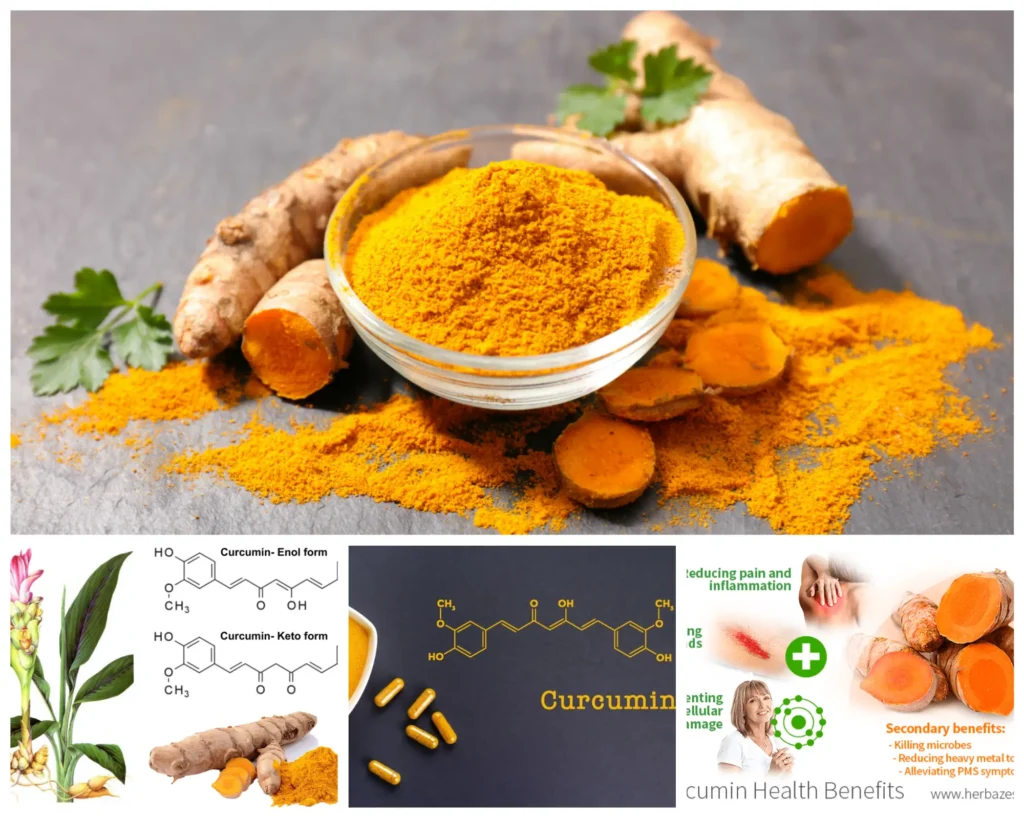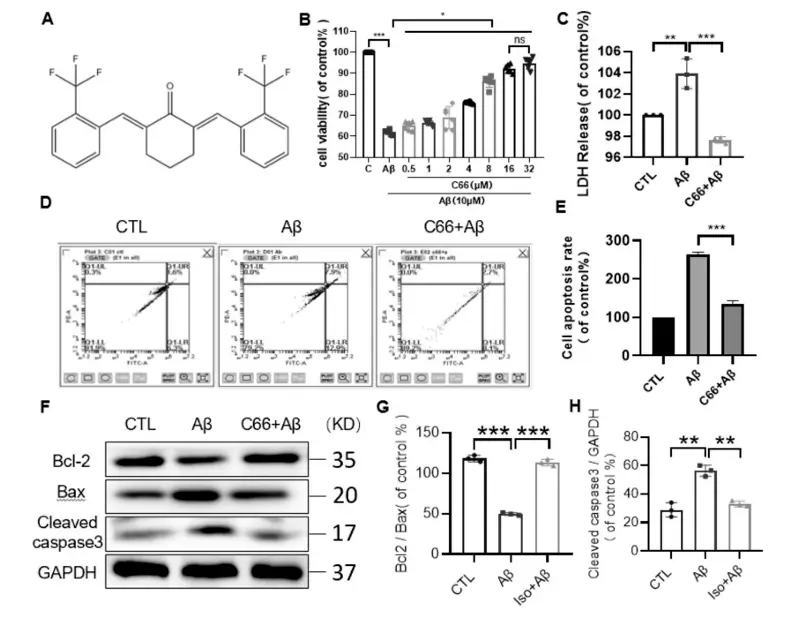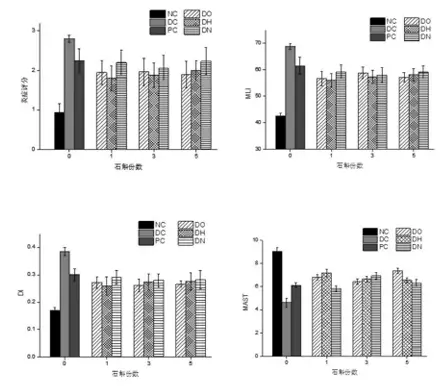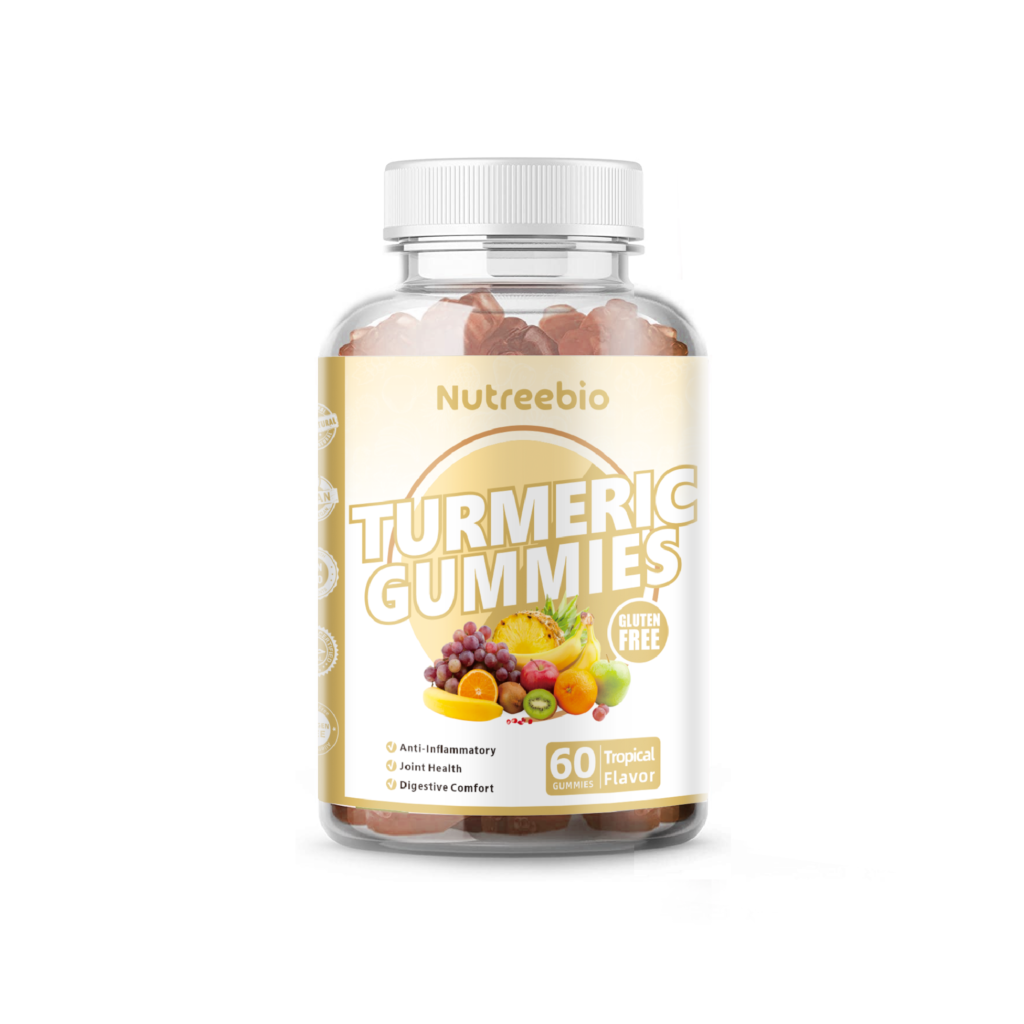Curcumin has a long history. It has appeared as a medicine in traditional Chinese medicine compound Chinese medicine and ancient Indian Ayurvedic therapy thousands of years ago. The rhizome of traditional Chinese medicine turmeric can extract 1% to 6% of curcumin compounds, of which curcumin accounts for 60% to 70% of curcumin analogs and is the most biologically active component. By modifying the chemical structure of curcumin to change the receptor binding ability and pharmacological activity of the drug molecule, curcumin derivatives can be formed to improve the overall pharmacological properties of curcumin. The phenolic hydroxyl group in the curcumin structure is most susceptible to hydrogen transfer reaction, and then metabolized into phenoxy, exerting antioxidant properties and removing reactive oxygen composed of molecular oxidants and free radical oxidants. Secondly, curcumin can act as a nucleophile to undergo Michael addition reaction with a strong electrophile to exert the cytotoxic effect of cancer cells, that is, anti-tumor activity. In addition, curcumin also has anti-inflammatory, anti-infection, and lipid metabolism regulation functions.


1. Health Benefits
A.Anti-tumor
Curcumin can alleviate the occurrence and development of malignant tumors in affected tissues and organs by inhibiting the abnormal proliferation, local infiltration, metastasis and invasion of tumor cells. Although the pathogenesis and clinical manifestations of malignant tumors in different systems are different or not completely consistent, curcumin has a broad-spectrum inhibitory effect on malignant tumors with extremely high incidence. At present, experiments on different gastric cancer cell lines and a series of gastric cancer animal model experiments have confirmed that curcumin and its analogs have antioxidant stress and chemosensitization effects, and can inhibit the invasion, proliferation and metastasis of gastric cancer cells through multiple signaling pathways of mitochondria-dependent or -independent pathways. The latest research results show that the combination of curcumin and its analogs and chemotherapy can significantly enhance the efficacy of gastric cancer chemotherapy by activating nuclear factor-κB (NF-κB) and upregulating apoptosis levels, thereby upregulating the sensitivity of gastric cancer cells to chemotherapeutic drugs. In addition, there are reports that curcumin can inhibit the expression of phase I metabolic enzymes in rat stomach, protect the formation of benzo[a]pyrene-induced DNA adducts, inhibit DNA damage, and thus inhibit benzo[a]pyrene-induced gastric carcinogenesis.
B.Protect cardiovascular
Atherosclerosis caused by dyslipidemia and ischemia-reperfusion injury induced by exogenous factors are common diseases of the cardiovascular system, and curcumin has the effects of lowering blood lipids and anti-oxidative stress, indicating the potential clinical application value of curcumin in cardiovascular diseases. In cell and mouse experiments, the protective effect of curcumin on cardiomyocytes may be achieved by downregulating the Notch pathway and downregulating the level of intracellular ROS. In addition, studies have confirmed that curcumin can reduce the decrease in H9C2 cell viability and pro-apoptosis induced by palmitic acid through the activation of the endoplasmic reticulum stress pathway. Coronary artery microembolism and vascular restenosis are common complications of percutaneous coronary intervention. Curcumin may inhibit the TLR4/MyD88/NF-κB signaling pathway, downregulate the expression of inflammatory factors tumor necrosis factor-α (TNF-α) and interleukin-1β (IL-1β), inhibit myocardial cell apoptosis and inflammatory response, and ultimately protect myocardial injury induced by coronary artery microembolism in rats.
C.Anti-diabetes
A study explored the effects of curcumin on glucose and lipid metabolism in a rat model of type 2 diabetes, and explored its effects on free fatty acids (FFA) and tumor necrosis factor α (TNF-α). The results showed that the AUC value of the curcumin treatment group was lower than that of the model group and was statistically significant (P<0.05). By measuring the levels of cholesterol (TC), triglycerides (TG), high-density lipoprotein cholesterol (HDL-C) and low-density lipoprotein cholesterol (LDL-C), it was found that the LDL-C level in the curcumin treatment group was significantly reduced (P<0.05). Therefore, curcumin treatment can significantly improve glucose and lipid metabolism disorders, enhance insulin sensitivity, and improve insulin resistance in rats with type II diabetes. At the same time, the study found that this method can significantly reduce FFA and TNF-α levels in rat models of type 2 diabetes. The mechanism by which curcumin improves insulin resistance may be related to the reduction of FFA and TNF-α in serum. At the same time, the results of the inhibitory activity of curcumin derivatives on amylase showed that curcumin derivatives have an inhibitory effect on amylase and are concentration-dependent, and they have significant inhibitory activity on amylase, which is similar to the inhibitory effect of acarbose.
2. Market and regulatory trends
Curcumin is very popular in many Asian countries. As early as 1981, China first permitted curcumin as a food additive for use in the food industry in the "Hygiene Standards for the Use of Food Additives". At present, China's standards for curcumin mainly include GB 2760-2014 "National Food Safety Standard Food Additive Usage Standard", GB 1886.76-2015 "National Food Safety Standard Food Additive Curcumin" and T/CCCMHPIE 1.48-2019 Plant Extract Curcumin. Among them, GB 2760-2014 stipulates that curcumin is a pigment food additive and can be consumed in a variety of foods such as cakes, beverages, beverage concentrates, alcohol, fruit and vegetable juices and fruit juice drinks, candied fruits, meat products, etc. Recommended dosage: Use in appropriate amounts according to colorant needs, with a maximum usage of 0.7 g/kg.
In other parts of Asia, India, Japan, and South Korea also have a lot of demand and application for curcumin, especially in traditional medicine.
In addition to its popularity in Asia, curcumin is also widely used in other regions of the world. In 1995, curcumin was approved as a food additive by the Codex Alimentarius Commission of the Food and Agriculture Organization of the United Nations.
The EU supports the ADI (acceptable daily intake) value of curcumin of 3 mg/kg bw/day based on reproductive toxicity studies. In addition, in 2022, a patented product of a US company: a certain brand of reduced curcumin has been approved as a new food by the European Food Safety Authority (EFSA). The product contains a curcuminoid derivative-tetrahydrocurcumin. This is the first time in history that a derivative of a nutrient has been approved as a new food in Europe.
3. Product application dynamics
Curcumin is one of the world's largest-selling natural food pigments and is a food additive approved for use by the World Health Organization, the US Food and Drug Administration and many countries. At present, curcumin and its derivatives are used in daily chemicals, sports nutrition, stress sleep and other directions. They are mainly used for dyeing canned foods, sausage products, and sauce products. The amount used is determined according to normal production needs. The product form of functional foods with curcumin as the main ingredient can be general food or some non-food forms, such as capsules, pills or tablets. For general food forms, some yellow pigment foods can be considered, such as cakes, sweets, beverages, Gummies, etc.
It is worth noting that Nutreebio has found in its many years of experience in Gummies that there is a difference between Curcumin and the turmeric ingredients in Turmeric gummies. Curcumin is an active compound extracted from turmeric, which has many health benefits such as anti-inflammatory and antioxidant, and is usually a high-concentration ingredient after purification. Turmeric is the powder of the whole turmeric root, which contains other ingredients, including volatile oils and other compounds in addition to curcumin. In our customized turmeric gummies, sometimes we recommend using turmeric powder directly, and sometimes we recommend (less often) using curcumin as the main ingredient, depending on the positioning and function of our customer's products.
For non-food forms, such as a certain brand of curcumin capsules, they use a special water-soluble technology to replace piperine, making curcumin highly absorbable. This product supports healthy responses associated with overwork and helps promote joint comfort; a patented product of turmeric extract with high bioavailability and cold water dispersible (CWD) launched by a certain company. In an aqueous environment (such as the stomach), the curcumin particles of this product can be freely dispersed, and it contains more than 80% curcumin content, which can provide a large number of active ingredients in a water-dispersible formula to achieve a higher absorption rate; in addition, a certain curcumin product combines functional raw materials such as turmeric, kudzu root, and Hovenia dulcis, and is made into a popular soft candy form, and the eye-catching words "Protecting Night Sleepers" are marked on the package to reflect the characteristics and target groups of the product. It is estimated that by 2027, the global curcumin market will exceed US$145 million. Improving its bioavailability, developing synthetic curcumin derivatives and analogs, using them in combination with pharmaceutical excipients, and changing product dosage forms may be the next market demand for curcumin products.
4. Current status of production technology
Alzheimer's disease (AD) is a progressive neurodegenerative disease with an insidious onset. At a time when the population is rapidly aging, the disease remains one of the biggest challenges in the global medical community. Senile plaques formed by the deposition of amyloid beta (Aβ) outside nerve cells are one of the main pathological characteristics of AD. Studies have shown that Aβ is formed by amyloid precursor protein (APP) cleaved by β-secretase and γ-secretase. Aβ142 oligomers are considered to have significant neurotoxicity, which can lead to synaptic plasticity disorders, neuronal damage, and inflammatory response, and stimulate the production of reactive oxygen species (ROS), ultimately promoting the occurrence and development of AD. cJun amino-terminal kinase (JNK) is one of the important members of the mitogen-activated protein kinase (MAPK) family in mammalian cells and plays an important role in cell apoptosis and inflammatory response. The phosphorylation level of JNK is significantly increased in the brain of AD patients. Phosphorylated JNK can not only promote the increase of Bax/Bcl2 ratio and caspase3 activation, and then induce cell apoptosis; it can also lead to p65 phosphorylation into the nucleus, promoting the transcription of cellular inflammatory factors. Curcumin derivative C66 is obtained by modifying the structure of curcumin. However, there are no reports on the application of curcumin derivative C66 in the treatment of AD.


5. Introduction to technical achievements
The purpose of this technology is to provide the application of curcumin derivative C66 in the preparation of functional foods, health products and medicines for the treatment of Alzheimer's disease. This technology uses Aβ1‑42-induced cell injury model and transgenic amyloid precursor protein (APP)/presenilin 1 (PS1) AD mice to study the preventive and therapeutic potential and potential mechanism of action of three products rich in curcumin derivative C66 - powder, dairy products and liquid beverages in AD. On cells, curcumin derivative C66 can reduce the production of ROS induced by Aβ1‑42, correct mitochondrial membrane potential and have a neuroprotective effect. In the APP/PS1 animal model, C66 effectively reduced the number of Aβ plaques, increased the expression of synaptic-related proteins, reduced neuronal apoptosis and the inflammatory response of major immune cells in the brain, and finally achieved AD treatment effects, revealing the potential of C66 as a new AD treatment or preventive drug. These findings are expected to provide new directions for the prevention and treatment of AD.


6. Conclusion
Curcumin derivatives have many pharmacological properties and have good research and application prospects. Under the mediation of multiple molecular pathways, curcumin has a positive biological effect on various systems and organs of the human body. However, the oral bioavailability of curcumin is relatively low. Therefore, the current research on drug development for curcumin structure modification, activity screening of curcumin analogs, derivatives, and metabolites with similar functions and their mechanism of action has a high research value. Although cell experiments, animal experiments and clinical trials have confirmed that the mechanism of action of curcumin is related to the interaction between multiple pathways, the specific molecular mechanism of curcumin in various signaling pathways has not yet been elaborated in detail. In addition, people still need to conduct clinical drug concentration screening experiments with different gradients for specific diseases of a certain system and the age range of patients to determine the safe and effective concentration range of curcumin.




One Response
Great Article bro thanks